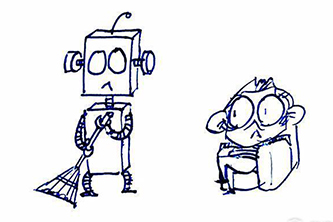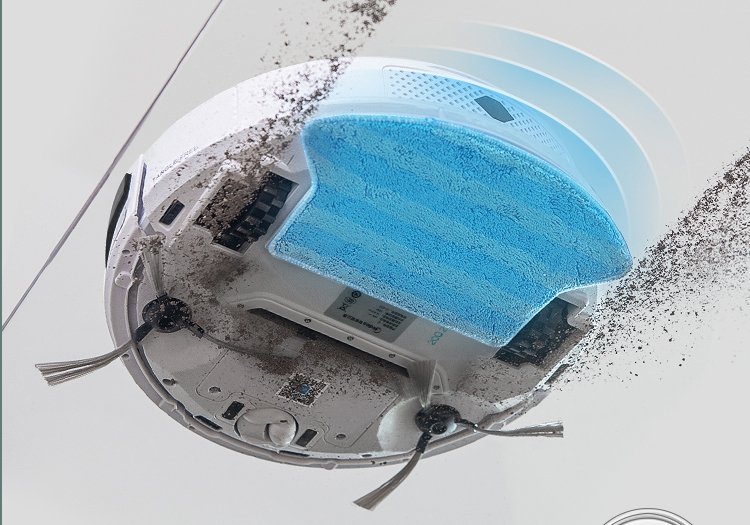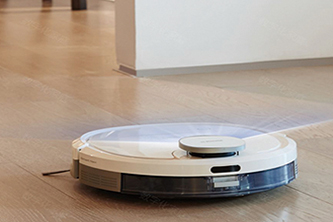The early sweeping robots basically cleaned randomly, so some places would be cleaned many times during the cleaning process, but some places could not be cleaned, and they did not have any navigation and positioning functions. In fact, whether a sweeper is smart or not, and whether it can clean the home is mainly due to its positioning and navigation methods. So what are the main positioning and navigation technologies for sweeping robots? At present, there are mainly the following five positioning and navigation technologies.
1. Beacon-based positioning of the sweeping robot
Beacon positioning originally refers to the technology that uses radio waves emitted by radio base stations to achieve positioning and navigation in navigation or aviation. For the indoor positioning of the robot, it means that the robot receives or observes the beacon at a known position in the environment through various sensors, calculates the relative position of the robot and the beacon, and then substitutes the known beacon position coordinates to solve the robot’s Absolute coordinates to achieve positioning. The beacon used for positioning needs to meet 3 conditions:
(1) The position of the beacon is fixed and the absolute coordinates of the beacon are known;
(2) The beacon has active and passive characteristics and is easy to identify;
(3) The position of the beacon is convenient for observation from all directions.
The beacon positioning methods mainly include trilateral measurement and triangulation. Trilateral measurement is a method of determining the position of a mobile robot based on the measured distance between the robot and the beacon. The trilateration positioning system requires at least 3 transmitters (or receivers) with known positions, and the receiver (or transmitter) is installed on the mobile robot. The ideas of triangulation and trilateral measurement are roughly the same, and positioning is performed by measuring the angle between the mobile robot and the beacon.
The beacon-based positioning system relies on a series of beacons with known characteristics in the environment, and needs to install sensors on the mobile robot to observe the beacons. There are many types of sensors for beacon observation, such as ultrasonic sensors, lidars, and vision sensors. It can be measured in real time without progressive errors, with relatively high accuracy and good stability, providing fast, stable, and accurate absolute position information, but the installation and maintenance of the beacon is expensive. There are more mature beacon positioning sweeping robots based on beacon positioning in the market, such as iRobot's Northstar navigation and positioning technology, but because of their relatively high price, they are all used in relatively high-end products.
2. The environment map model matching and positioning of the sweeping robot
The sweeping robot detects the surrounding environment through its own various sensors, uses the local environment information it senses to construct a local map, and matches with the complete map stored in advance. Get your own position in the global environment through the matching relationship to determine your own position. This method is only suitable for some relatively simple environments due to strict conditions.
3. Vision-based positioning of the sweeping robot
Scientific research statistics show that about 75% of the information that humans obtain from the outside world comes from vision, and the visual system is the closest detection method for robots and humans to perceive the environment. Benefiting from the development of pattern recognition and machine vision, vision-based robot positioning has become a research hotspot in recent years.
Vision-based positioning is mainly divided into monocular vision and binocular vision:
Monocular vision cannot directly obtain the three-dimensional information of the target. It can only obtain the depth information of the feature points in the environment by moving. It is suitable for situations where the work task is relatively simple and the depth information requirements are not high. If the geometric shape model of the target object is used, the target Taking more than 3 feature points from the top can also obtain information such as the location of the target, but the positioning accuracy is not high.
Binocular stereo vision three-dimensional measurement is based on the principle of parallax, that is, as long as any point on the left camera image plane can find the corresponding matching point on the right camera image plane, the three-dimensional information of the point can be determined and its corresponding The three-dimensional coordinates of the point.
4. Map matching method of sweeping robot
The robot detects the surrounding environment through its various sensors, uses the local environment information it senses to construct a local map, and matches with the complete map stored in advance. Get your own position in the global environment through matching relationships. This method is greatly affected by the environment layout and is only suitable for some relatively simple environments.
5. Image matching method of sweeping robot
The robot obtains the image information of each feature point in the environment by moving in advance, and uses the geometric shape model of the target object to take more than 3 feature points on the target and match the detected image feature points. It is a kind of fingerprint positioning method.
Restricted by factors such as component cost, performance and production, dead reckoning algorithm is still the most widely used positioning method at present, but through algorithm optimization, the introduction of mixed positioning of multiple positioning technologies can reduce the cumulative error caused by it. Negative impact.
Sweeping robots are still an emerging industry. An important issue that restricts the development of sweeping robots is that the robots will occasionally fail to find their way and return to the base for charging, resulting in incomplete cleaning or failure to return. Another problem is that, limited by its small size, the sweeping robot has low power and its cleaning ability cannot be compared with a vacuum cleaner. If the two major problems can be solved smoothly, robot vacuum cleaners will usher in new development opportunities, and consumers will enjoy a more convenient life and be liberated from boring housework.


